Gates into former Dachau complex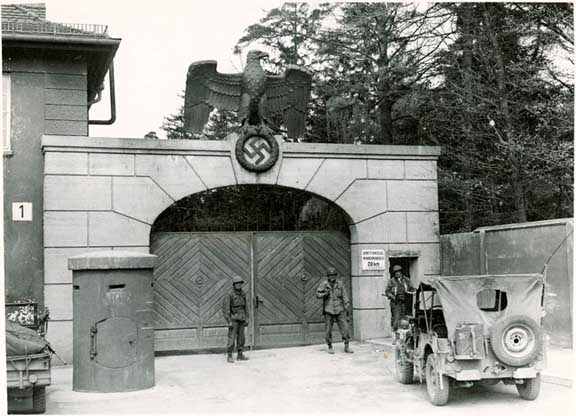 The whole Dachau camp complex was located on the grounds of a former gun powder and munitions factory, which had been built in 1915. The complex consisted of two completely separate camps. The largest one, which was known as the SS-Übungslager, was the SS Training Camp and Garrison. The smaller of the two camps, known as the Konzentrationslager, was the prison compound. The two camps were separated by the Würm river, a concrete-lined canal which runs north in a straight line along the western border of the former Dachau concentration camp. The photograph below is the view looking south, which shows the concentration camp on the left and a row of poplar trees on the right. The concentration camp was surrounded by a solid wall on three sides with the Würm river forming a moat on the fourth side, as shown in the photograph below. The SS camp was located to the west of the concentration camp, behind the row of trees.  The SS camp was an army base for two groups of SS soldiers: the Totenkopfverbände and the SS-Verfügungstruppe. The Totenkopfverbände was the Death's Head Unit which served as concentration camp guards and administrators, while the SS-Verfügungstruppe later became famous as the Waffen-SS troops who were combat soldiers. The SS garrison and the concentration camp were completely separate, each with its own Commandant. Prisoners coming into the concentration camp had to first pass through a gate into the SS-Übungslager and then through the Jourhaus gate into the prison compound. There were four gates into the SS-Übungslager: the main entrance near the concentration camp, another gate on the southwest side of the SS camp for the SS soldiers, a gate for vehicles on the south side of the complex and a railroad gate for trains on the southwest side. The very few prisoners, who were brought all the way to the concentration camp on a train, entered through the railroad gate, at the southwest corner of the camp near the gate shown in the first photograph above. On the day that the Dachau concentration camp was liberated, the 45th Thunderbird Division of the US Seventh Army entered through the railroad gate, while the 42nd Rainbow Division arrived a short time later to accept the surrender of the concentration camp near the vehicle gate on the south side. The gate, which is shown at the top of this page and in the photograph below, is the one on the southwest side of the SS camp. 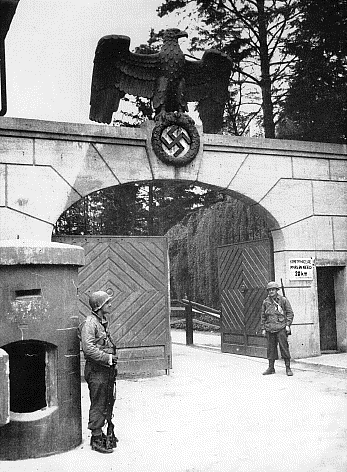 The main entrance into the SS-Übungslager is shown in the photograph below. 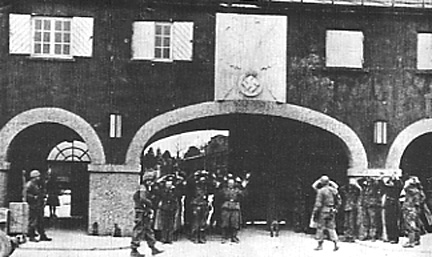 The main entrance into the SS complex, shown in the photograph above, was through a building on the south side of the complex, on the city street named Avenue of the SS, which is now called Strasse der KZ-Opfer (Street of the Concentration Camp Victims). In front of the main entrance is where Eicke Plaza once stood. The plaza was a rectangular area that was laid out in a precise pattern of paths like a formal garden; it was named after Theodor Eicke, the second Commandant of the Dachau concentration camp. This plaza is no longer in existence and the area is now a soccer field. After going through one of the entrances into the SS camp, the prisoners walked past a block of factory buildings in the SS-Übungslager, then crossed a stone bridge over the Würm river canal and entered through the gatehouse, shown in the photograph below. This is the gate which has the infamous "Arbeit Macht Frei" sign. 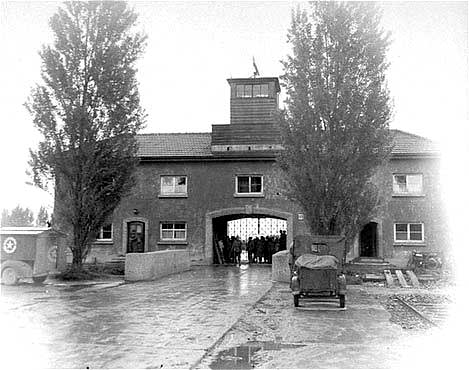  The original poplar trees, which once flanked the gate house, are now long gone and several other trees have replaced them. The photograph below shows houses and apartments on Pater-Roth-Strasse, which is the street taken by the number 726 bus as it goes back from the Memorial Site to the main train station. Pater-Roth-Strasse is just a few yards north of the parking lot on Alte-Römerstrasse; it runs east and west on the south side of the camp complex. A short way down this street, you will see a bridge over the Würm river, shown in the photograph below.  The Würm river runs in a perfectly straight line, through a canal, forming a moat along the western border of the former concentration camp. The houses, shown in the photo above, are located directly behind the former bunker that is behind the Museum building in today's Memorial Site, and can be seen by visitors inside the former camp. The photograph below shows a gate on Pater-Roth-Strasse, just west of the bridge in the photograph above. This gate is in the approximate location of another entrance into the SS complex on the south side. Most of the former SS buildings have been torn down; the former garrison was off limits to visitors when I visited Dachau in 2007. 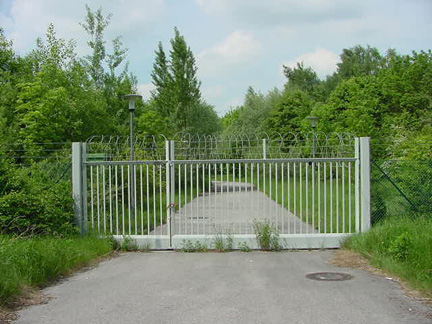 The area that was formerly the SS Training Camp and Army Garrison is now occupied by the Bavarian police. The gate below is an entrance to the police headquarters. In the background is one of the white buildings that was originally part of the old munitions factory and then the SS-Übungslager. This gate is on the southwest corner of the complex near where the original gate with the Nazi eagle on top once stood.  The grounds of the former SS camp are not accessible to visitors today. A fence surrounds the old garrison and trees hide most of the remaining buildings. The photograph below shows one of the buildings that is still standing. This was taken from the street that leads to the preserved section of the railroad branch line that formerly ran into the SS camp through the railroad gate at the southwest corner.  After the Dachau complex was liberated by the US Seventh Army, American soldiers occupied the former SS barracks from 1945 until 1973. The army encouraged American soldiers from all over Germany to visit the Dachau gas chamber building on the west side of the Würm river, where a museum had been set up to educate the soldiers about the gassing of prisoners at Dachau. This museum was open until 1953 when it was closed due to protests from the Bavarian government. From June 1945 until August 1948, the former concentration camp on the east side of the Würm river was occupied by accused German war criminals who were awaiting trial in a courtroom set up in the former SS Training camp at Dachau. From 1948 to 1965 the former concentration camp was occupied by German refugees who had lost their homes when 12 to 18 million ethnic Germans were expelled from German territory given to Poland and to what is now the Czech Republic. These refugees were relocated to housing in a new suburb of Dachau to make way for the Memorial Site. Today's Pater-Roth-Strasse is named after Father Roth, a Catholic priest who was a prisoner in the Dachau concentration camp. He stayed on when the concentration camp was turned into a prison for the German war criminals and later also served as the priest for the German refugees. Preserved railroad tracksThe Avenue of the SSHistory of the SSBack to SS CampBack to Table of ContentsHomeThis page was last updated on June 21, 2007 |